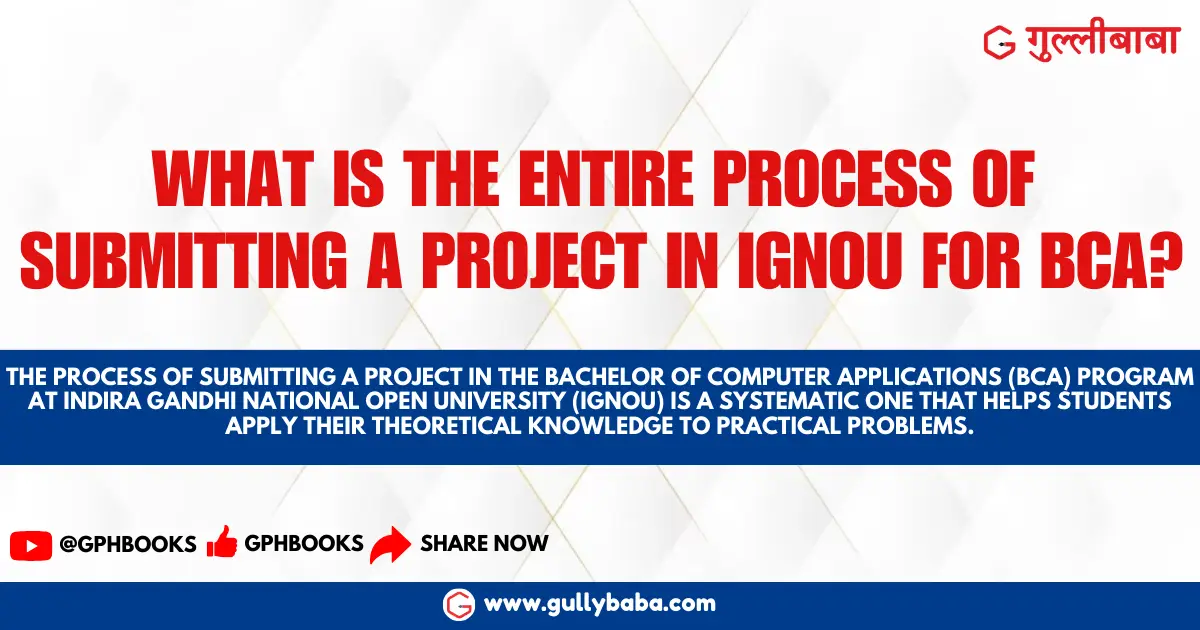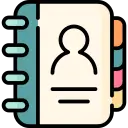The process of submitting a project in the Bachelor of Computer Applications (BCA) program at Indira Gandhi National Open University (IGNOU) is a systematic one that helps students apply their theoretical knowledge to practical problems.
What is the entire process of submitting a project in IGNOU for BCA?

- The following steps outline the entire process
- How long does it take to get a project proposal approved by IGNOU (BCA)?
- 2. What does the IGNOU BCA project front page contain?
- 3. How tough is Viva for an IGNOU BCA project?
- IGNOU BCA Project Viva Questions
- 4. How to prepare your IGNOU BCA Project Report with great ease and comfort?
- 5. What are the carrier options available after doing BCA from IGNOU Successfully?
- 6. Top Tips for MCA Project Report Preparation
- Selecting the Right Topic
- Thorough Literature Review
- Methodology and Implementation
- Data Collection and Analysis
- Interpretation and Conclusion
- Formatting and Editing for Submission
- Conclusion
The following steps outline the entire process
- Choose a Project Topic: Start by selecting a project topic that aligns with your course curriculum and interests you. Make sure the topic is realistic and feasible given the time and resources available.
- Develop a Project Proposal or Synopsis: After choosing the topic, create a project proposal or synopsis, which outlines the scope of your project. It typically includes the title, objectives, methodology, and potential outcomes of your project.
- Submit the Project Proposal: The project proposal must be submitted to the Regional Director of your respective IGNOU Regional Centre for approval. Make sure to submit your proposal before the deadline given by IGNOU.
- Assign a Project Guide or Supervisor: Upon approval of your project proposal, assign a project guide or supervisor. They can be a faculty member or a professional related to the field of your project. IGNOU provides a list of approved project guides that you can choose from.
- Work on the Project: Start working on your project under the guidance of your project guide. Regular consultation with your guide is recommended to ensure that your project stays on track.
- Prepare the Project Report: Once your project work is complete, document all your work in a project report. The project report usually includes sections like introduction, literature review, methodology, results, discussions, conclusion, and references.
- Submit the Project Report: After completing the project report and getting it signed by your project guide, submit it to the IGNOU Regional Centre. Make sure to keep a copy of the project report for your records.
- Attend the Viva Voce or Oral Examination: After the project report submission, you'll be called for a viva voce. This is an oral examination where you'll be asked questions about your project. It is a crucial part of the project submission process.
Please remember to adhere to all deadlines for proposal and project report submissions. Ensure that your project report complies with the formatting guidelines provided by IGNOU and that all the work submitted is original. Plagiarism may lead to the rejection of your project. It's also advisable to review the IGNOU BCA project handbook or guidelines thoroughly before you start your project work.
How long does it take to get a project proposal approved by IGNOU (BCA)?
The time taken for a project proposal's approval at Indira Gandhi National Open University (IGNOU) may vary, as it depends on multiple factors such as the volume of proposals submitted, the specific course or department, and the academic calendar.
However, typically, it can take anywhere from a few weeks to a couple of months for IGNOU to review and approve a project proposal for the Bachelor of Computer Applications (BCA) program. Students should anticipate this waiting period when planning their project timelines.
It's important to check the guidelines specific to your program and follow any updates from IGNOU regarding the project submission and approval process. If your project proposal gets approved, you'll be notified, usually through official communication from your Regional Centre.
2. What does the IGNOU BCA project front page contain?
The front page, also known as the title page, of the IGNOU BCA (Indira Gandhi National Open University, Bachelor of Computer Applications) project provides important information about the project, the student, and the institution. The formatting and content might vary based on specific guidelines, but generally, it includes the following elements:
- University Name: "Indira Gandhi National Open University" should be mentioned at the top of the page, generally centered and in bold letters.
- Project Title: The title of the project should follow next. It should be written in a clear, concise manner and should be centered on the page.
- Course Name and Code: You should mention the course name, i.e., "Bachelor of Computer Applications" and its corresponding code.
- Project Report/Dissertation/Thesis Statement: This denotes the type of document being submitted. For instance, it can be stated as a "Project Report submitted for the partial fulfillment of the Bachelor of Computer Applications (BCA)".
- Student's Details: Include your name and the enrollment number as per the university records.
- Supervisor's Details: The name, designation, and department of your project supervisor or guide should be mentioned.
- Submission Date: Indicate the month and year of the project submission.
- Study Center Details: Mention the name and address of your study center.
Remember, the contents of the front page should be centered and presented in a clear, uncluttered way, with ample spacing between each line for better readability. The exact details and their placement can vary based on the guidelines provided by IGNOU.
It's worth noting that the front page is usually followed by a certificate page, acknowledgment, abstract, and table of contents before starting the main body of the project report. Always adhere to the official guidelines provided by the university when preparing your project report.
3. How tough is Viva for an IGNOU BCA project?
The viva voce, or oral examination, for the Indira Gandhi National Open University (IGNOU) Bachelor of Computer Applications (BCA) project is an essential part of the evaluation process. It provides an opportunity for you to defend your work and demonstrate your understanding of the subject matter.
The level of difficulty can vary depending on several factors, including the complexity of your project, your preparation level, and your ability to effectively communicate your work and findings.
Here are a few factors to consider:
- Depth of Understanding: The viva is an opportunity to demonstrate your understanding of your project and the broader theoretical context. The panel will not only be interested in the results but also the process - how you approached the problem, the methodology you chose, and why.
- Communication Skills: You must be able to articulate your thoughts clearly and convincingly. If you can explain your project's intricacies in a way that is easily understandable, it will go a long way in making your viva successful.
- Preparation: Familiarize yourself with potential questions and practice your responses. Going over your project multiple times and anticipating possible questions can help reduce anxiety and make the viva easier.
- Problem-solving Skills: Sometimes, the viva panel may ask you about problems you encountered during your project and how you resolved them. This is to assess your problem-solving and critical-thinking skills.
Remember, the purpose of the viva is not just to test your knowledge but also to see how you apply theoretical concepts in practice. If you thoroughly understand your project and are well-prepared, you should be able to handle the viva successfully.
IGNOU BCA Project Viva Questions
During the viva voce for the IGNOU Bachelor of Computer Applications (BCA) project, you will be asked questions to test your understanding of your project and your ability to apply the theoretical concepts learned during your course. Here are some potential questions you might encounter:
- Can you briefly explain your project and its objectives?
- What motivated you to choose this particular topic?
- Can you explain the methodology used in your project?
- How does your project align with the concepts studied in your BCA program?
- What challenges did you face while working on this project and how did you overcome them?
- What are the key findings or results of your project?
- How could the results of your project be used in a real-world context?
- How have you ensured the reliability and validity of your findings?
- Can you discuss the software tools or programming languages used in your project? Why did you choose them?
- What improvements or enhancements would you suggest for your project?
- What ethical considerations did you have to make during your project?
- How does your project contribute to the field of computer applications?
- What lessons have you learned from the process of doing this project?
Remember, the viva is not only a test of your project work but also an assessment of your understanding of the broader field. It's advisable to revisit your project work, understand all aspects of it thoroughly, and be prepared to discuss it confidently. Don't forget to brush up on your fundamental concepts from your BCA coursework, as they can also be a part of the discussion.
4. How to prepare your IGNOU BCA Project Report with great ease and comfort?
Completing your IGNOU BCA (Bachelor of Computer Applications) project can indeed be a smooth process if approached strategically. Here are some steps to ensure you complete your project with ease and comfort:
- Understand the Guidelines: Start by thoroughly understanding the project guidelines provided by IGNOU. This will give you a clear picture of what is expected in the project, including the format, submission process, and evaluation criteria.
- Select a Relevant Topic: Choose a topic that aligns with your course and piques your interest. Having a genuine interest in your project topic can make the research and implementation process much more engaging.
- Plan Your Time: Divide your project into manageable sections and create a timeline for each. Include time for topic selection, research, writing the proposal, project development, writing the project report, and preparing for the viva.
- Find a Good Project Guide: Having a good project guide can make a big difference. They can provide valuable feedback, help you troubleshoot issues, and guide you in the right direction.
- Research Thoroughly: Make sure you do thorough research on your chosen topic. Use varied sources such as books, academic journals, and reputable online sources. This will deepen your understanding and provide a solid foundation for your project.
- Follow a Strict Routine: Consistency is key in a project of this magnitude. Make sure you devote a certain amount of time each day to your project. This regular commitment can help you progress steadily without feeling overwhelmed.
- Write as You Go: Instead of leaving all the writing until the end, try to document your findings and progress as you go. This can make the task of writing your final report less daunting.
- Seek Feedback: Don't hesitate to seek feedback on your work from your project guide or peers. They can provide a different perspective and help you improve your work.
- Proofread and Edit: Always allocate time for proofreading and editing your project report. Look for grammatical errors, and typos, and ensure that the report is clear, concise, and coherent.
- Prepare for Viva: The viva voce is an important part of the project. Make sure you know your project inside out and can answer any questions posed by the examination panel.
- Take the help of a Big Player in this Field: Yes, you read it right. There are some publishing companies with decades of seamless records in helping IGNOU Students prepare their Project Reports. You can take it and use it as a Reference. When a prototype of your project report comes in, you can make your project report with great ease and comfort.
Remember, a systematic approach, diligent work, and continuous effort are keys to completing your BCA project at IGNOU with great ease and comfort.
5. What are the carrier options available after doing BCA from IGNOU Successfully?
Earning a Bachelor of Computer Applications (BCA) degree from the Indira Gandhi National Open University (IGNOU) can pave the way for numerous job opportunities in the tech industry and beyond. Here's a list of potential career paths you can consider:
- Software Developer/Engineer: Professionals in this role focus on the design, testing, and creation of software to meet the specific needs of users. This software can be system software or application software.
- Web Developer: As a web developer, your responsibility would be to build websites or web applications. You can specialize in different areas such as front-end, back-end, or full-stack development.
- Systems Analyst: Systems analysts leverage their knowledge of business and IT to evaluate an organization's systems and procedures, then suggest enhancements to boost efficiency.
- Database Administrator: In this role, you would handle the design and management of databases, ensuring data remains safe, well-organized, and accessible to authorized personnel.
- Network Administrator: Network administrators oversee an organization's networks, ensuring security, efficient operation, and performing necessary updates.
- IT Project Manager: This role involves the management of projects from the initial planning stage to implementation. The goal is to ensure projects are delivered on time, within budget, and meet business requirements.
- Data Scientist: For those interested in statistics and big data, a data science career could be a suitable option. Data scientists analyze substantial datasets to aid businesses in making informed decisions.
- IT Consultant: As an IT consultant, you can work on your own or with a consulting agency to offer expert advice to businesses on the optimal use of IT to accomplish their objectives.
- Technical Writer: For those with strong writing abilities, you could craft guides, manuals, and other documents that aid users in understanding technological concepts and tools.
Further education, such as pursuing a Master of Computer Applications (MCA) or Master of Business Administration (MBA), can also be a consideration to expand career opportunities and diversify potential roles. Ultimately, the career path you decide on should resonate with your individual interests and align with your long-term career aspirations.
6. Top Tips for MCA Project Report Preparation
Introduction
So, you've finally reached the end of your MCA program and you're all set to submit your MCA project report. But hold on! Are you sure your project report is up to the mark? This is where a well-prepared MCA project report comes into play. It's not only a mere reflection of your hard work and dedication, but also a gateway to your future endeavors. Simply put, an MCA project report is a document that captures your research and findings during the Project Period.
And, you guessed it right, faultless submission means a report that is worth the reader's time and attention. It's like making a good impression on your first interaction! So, why is faultless submission important? It's the best way to convey your expertise, skills, and knowledge. Your report can make a solid foundation for your career growth. Plus, it gives you an opportunity to showcase your creative writing skills.
Selecting the Right Topic
Selecting the right topic for your MCA Project Report is quite crucial. You don't want to spend endless hours on a topic that doesn't interest you, aligns with your goals, or has feasibility issues. So, let's start with choosing a topic that piques your interest. Think of what you're passionate about and how it relates to your course. This will make your research enjoyable and keep you motivated.
Next, align your topic with your goals. Ensure it's relevant to your career aspirations, and sharpening skills that you will use. This will add value to the learning process and boost your confidence level. Lastly, make sure your topic is feasible and practically correct. Consider the resources available to you, i.e., time, cost, and availability of data. At this point, you may need to refine your topic or switch to a more doable one.
Simply put, selecting the right topic sets the tone for your entire project report. So take your time, do your research, and critically evaluate your options.
Thorough Literature Review
Are you struggling to come up with ideas on how to conduct an efficient and effective literature review for your MCA project report? Worry not! In this section, we will guide you on how to do thorough background research in a way that will set you apart from the rest!
First, you need to do some library scavenging - online and offline to gather as much relevant information as possible. It is essential to read the documentation carefully to understand the theme, and that's where we perceive the theme! After getting the theme, you should analyze different patterns in various documents to identify research gaps.
Now, this is where things get interesting; after identifying the gaps, you get to establish how your research will fill those gaps. This will aid in the development of informed objectives and outline the research procedure to achieve them. We encourage you to use the internet since it can sometimes be a library of its own. However, be careful not to become a victim of information overload.
In order to reap maximum benefits from your internet searches, keep refining your search terms and ensuring that the sources you use are credible. Remember, it's not about the number of documents you read, it's about the quality of information that you extract from them. So, choose your sources diligently and analyze them critically.
In summary, a literature search is much like a treasure hunt and it's imperative that you cover significant ground to get the best possible prize. Nonetheless, taking extreme care not to veer off subject and addressing the research issues is key. Now that you've got a handle on literature searching go forth and dig up those sources!
Methodology and Implementation
When it comes to methodology and implementation, it's essential to have a fail-proof plan in place. Outlining the research procedure is the first step, which involves setting objectives, defining constructs, and identifying programs to be used. The research should be designed in such a way that it meets the objectives while also being feasible to conduct.
Defining objectives and constructs is crucial since these are the building blocks of the research. A poorly defined objective can result in inappropriate research findings, while ambiguously defined constructs can lead to ineffective data collection and analysis. When it comes to describing programs used, it's essential to choose software that is well-known and commonly accepted. This helps in verifying the findings and making it easier for other researchers to follow and build on the research.
The goal is to have a clear and concise methodology that is transparent and easy to follow. The focus should be on the research objective, with the tools and programs used being secondary.
Data Collection and Analysis
Selecting the right data type is crucial for obtaining accurate results. You don't want to end up with a biased dataset that can distort the entire report. Once you have the data, it's important to clean and preprocess it, so that it's free from any errors or anomalies. This is a tedious process but necessary, as you don't want to miss out on any important information.
When it comes to data analysis, there are a variety of methods to choose from, such as descriptive statistics, regression analysis, and machine learning algorithms. However applying the right method that fits your research question is what will make your report a success.
Remember, data analysis is not just about numbers, it's also about storytelling. So, make sure you use your data to tell a compelling story that will keep your readers engaged
Interpretation and Conclusion
Alright, we’re almost there! You’ve nailed the methodology, collected and analyzed the data, and now it’s time for the grand finale – the interpretation and conclusion. This is where you bring it all home (no pressure or anything). First, let's summarize the approach and the results.
By now, you should have a pretty clear idea of what your project is all about and what it aims to achieve. Summarize the key findings and see how they tie back to your objectives. Next, it's time to interpret those findings. What do they actually mean? This is where you get to flex your analytical muscles and come to some conclusions. Based on your analysis, what did you learn?
What's important to note here is that your interpretation should be based on the evidence you have gathered. Lastly, don't forget to highlight the limitations of your study. No research project is perfect, after all. Be honest about the shortcomings of your approach or methodology and indicate possible areas for future research.
Overall, at the end of the day, what matters is that you’ve done your best - and that you sound like you know what you’re talking about. So go ahead, make those conclusions, and nail that interpretation like you’re interpreting a particularly abstract piece of art.
Formatting and Editing for Submission
You might have put your heart and soul into creating a perfect MCA project report, but with poor formatting and editing, it may be a lost cause. Ensure to use appropriate formats and styles throughout your report, making it consistent and coherent. With In-text citations and a comprehensive bibliography section, your report will have credibility.
Most importantly, make sure to proofread and review your report multiple times to ensure error-free content. Remember, your report is a reflection of your academic abilities, so make sure that your formatting, and editing is impeccable.
Conclusion
So there you have it - the ultimate guide to creating a faultless MCA project report! Remember that submitting a well-crafted report is crucial for good grades, and more importantly, for your own learning. So, choose a topic you're passionate about, conduct a thorough literature review, follow a detailed methodology, collect and analyze data accurately, and draw robust conclusions.
Don't forget to format and edit your report meticulously before submission. Following these steps from start to finish will ensure that you submit a report that's truly out of this world. Happy report writing!







